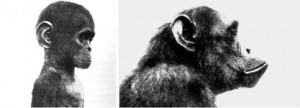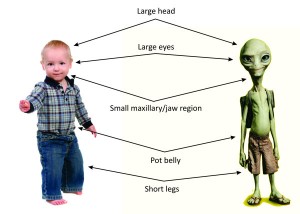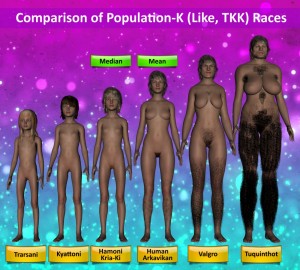2014
Apr
18
Neoteny in The Banak-Zuur Universe
I called it the Banak-Zuur universe not because Those of Banak-Zuur consider it their personal property, but because it is the universe in which that set of stories takes place. But the universe is not the topic here. The keyword is neoteny.
Never heard of it? Well, unless you are a physical anthropologist or evolutionary biologist, there is a good chance you wouldn't have. It refers to the retention of juvenile characteristics into adulthood, and is related to a similar term, pedomorphism, which is the possession of child-like features.
You see neoteny in nature. Some insects start out as maggots and end up as flies; others hatch looking just like the adults. Or rather, the adults look like juveniles. That's neoteny in the insect world, but let's take a moment to check it out closer to home: humans.
Neoteny and the Human Species
 Yes, among primates, humans are quite the example of neoteny. Didn't know you looked like a child, did you? But you do. Take a look at these widely circulated comparison photos of an infant and adult common chimpanzee, one of our two closest genetic relatives, as published in The Mismeasure of Man by Stephen Jay Gould. The infant's face doesn't look too unlike a human face, but check out the adult! The area between our eyes and chin become proportionally larger as we mature, but we sure don't grow a snout. We're baby-faced!
Yes, among primates, humans are quite the example of neoteny. Didn't know you looked like a child, did you? But you do. Take a look at these widely circulated comparison photos of an infant and adult common chimpanzee, one of our two closest genetic relatives, as published in The Mismeasure of Man by Stephen Jay Gould. The infant's face doesn't look too unlike a human face, but check out the adult! The area between our eyes and chin become proportionally larger as we mature, but we sure don't grow a snout. We're baby-faced!
But flat faces are not the only juvenile feature we hang onto. Large brains. Lack of body hair. Infantile ear shape. Small teeth. The shape of our hands and feet. People who really understand this have a rather long list of human neoteny features. And why are we so childlike? Because we're intelligent (or nearly so).
The connection may not be immediately obvious, and I am no evolutionary biologist to have any competence in explaining it, but the rationale goes something like this: intelligence is connected to larger brain size, which is connected to slower development, which is connected to prolonged parental care, which is connected to other characteristics of neoteny. Don't those big, beautiful eyes just make you want to cuddle? It's a nurturing signal among terrestrial mammas, and in my universe, primates across the universe. If you find this topic utterly fascinating, which it is, you can start here.
Biology is pretty clear: if we're clever enough to do quantum mechanics and rocket science, then it's because we're locked into looking like children. Welcome to the world of neoteny.
Neoteny and the Little Green Man
 Even without a background in physical anthropology or evolutionary biology, a lot of people seem to have made the connection between intelligence and neoteny, particularly science fiction writers and artists1. The neotenous alien is a long-standing trope. Let's make a comparison between a human toddler and Paul, the prototypical and archetypal little green man.
Even without a background in physical anthropology or evolutionary biology, a lot of people seem to have made the connection between intelligence and neoteny, particularly science fiction writers and artists1. The neotenous alien is a long-standing trope. Let's make a comparison between a human toddler and Paul, the prototypical and archetypal little green man.
OK, the pot belly is something of a joke because it is not on anyone's list of neotenous features, but I couldn't help but notice the abdominal resemblance. The others all are on those lists. The biggest difference between the two is that the toddler doesn't smoke! In fact, if you don't find the similarity striking, I'll be forced to wonder about you. It's as if there is some hereditary genetic memory in our species that programs us to understand the link between intelligence and neoteny, if not on an academic basis, at least instinctively somehow.
And it doesn't stop with Paul. Look at good old E.T., with his perky little mouth and nose and humongous, adorable eyes in that big head, and those short legs underneath. It's a definite trend. Ever wonder why in those children's cartoons they always make the characters with big heads and eyes? Hardly by accident. It's all connected, but I'll leave you to research that angle on your own.
For reasons that become obvious in the series, I couldn't have my super-intelligent neotenous aliens looking like little green men. Some of the scenes are eye-raising enough as is; and little green men would would be over the top. So they look like pint-sized humans. As history would have it, I didn't have any of this in mind when I first wrote Ritee and Nekalee; I originally dreamed them as child-sized adults (I have some really extreme dreams at times; perhaps I couldn't write without them), but when I got to piecing together the backstory, I realized that such was a detail that fit so perfectly into the Grand Scheme of the Universe that I couldn't even think about changing it.
Before moving on to the next topic, I just have to show you these photographs I ran across while researching alien neoteny. I stole one of them to show here as a thumbnail, but you absolutely have to go to Trend Hunter and give due respect to the photographer, Francesco Sambo. They're freaking beautiful! You wouldn't have met Mellia yet; she's in The White Shamitz and that isn't likely to be out before the end of the year, but if #4 were blond, she could almost be her. Her people aren't much more neotenous that humans, but they do have those adorable big eyes.
Neoteny and Population-K
I prepared this graphic of young adult females2 from various humanoid (Population-K) species that every educated person should be familiar with. Being a human myself, I suppose I'm partial to the human herein, but then I've never met a girl like Jaxidreshny, so it's hard to predict what effect that would have.
 There are such variations as serrated pupils, smooth tongues, different numbers of teeth, and differences in eye color. As is plain to see, body hair increases in quantity, density, and placement from left to right: the three left-hand figures never have a reason to shave their legs or armpits (they probably wouldn't care anyway) and Tuquinthot women grow hair on their chests and faces. Trarsani and Hamoni are invariably light blond and Kyattoni never are. Differences in sexual anatomy are obvious in the Trarsani and Kyattoni.
There are such variations as serrated pupils, smooth tongues, different numbers of teeth, and differences in eye color. As is plain to see, body hair increases in quantity, density, and placement from left to right: the three left-hand figures never have a reason to shave their legs or armpits (they probably wouldn't care anyway) and Tuquinthot women grow hair on their chests and faces. Trarsani and Hamoni are invariably light blond and Kyattoni never are. Differences in sexual anatomy are obvious in the Trarsani and Kyattoni.
But the overall trend is what's important. The Trarsani are the most neotenous intelligent primates — and the most biologically, intellectually, and socially advanced race — in the known universe. The Kyattoni run a close second. That the Kyattoni are now about 70,000 years more technologically advanced than the Trarsani is a historical accident you'll have to read about. Elagdoob of the Moorga complains that "the smaller they are, the more powerful and dangerous they are." That's true in a sense, but the Trarsani are only dangerous to beings like the Moorga. At the opposite end of the spectrum are the less neotenous — more hypermorphic — races. There aren't as many of them, but there is more room for variety and extravagance in that direction. Some extreme cases reach heights of 12 feet and look to us rather like rock trolls. I should go back and give them snouts.
On Kamphis, Terrik is able to spy without raising any suspicions because, at 18 and about as neotenous as a Hamoni, he is naturally mistaken for a first-grader, just as humans naturally mistake Ritee and Nekalee for children. It's all relative.
There is a strong positive correlation between neoteny and cooperative social behavior. Virtually all of the non-competitive races are more neotenous than humans. The more hypermorphic races, on the other hand, tend to be less intelligent and more belligerent, which explains why Oss/hox recruits so many Valgro and Tuquinthot. Humans and Arkavikans, you might have noticed, lie right at the threshold, and individuals can go either way — Gandhi or Hitler. We are quite confusing to many races who know about us; they rather see us a loose cannons. For you statisticians out there, humans lie at about the mean, but are more hypermorphic than the median.
Of course, just why there are so many Population-K species is a long-standing unanswered question. So is why they are distributed in space the way they are, and why pronounced neoteny diverged only recently. They're all pieces of one big puzzle. Of course, as the author, I know how those pieces fit together, but I obviously can't say anything about it here. You're not supposed to find out until Tetragrammaton, the last book in the series.
Neoteny and Sex
I really need to bring this up because it's an essential theme to the overall story line, and we'd never get to the end of the last volume without it. That, and you probably double your Google page ranking just by having the word sex in there someplace. I'm sure there are a lot of people, especially Americans, who will vomit at the prospect of putting "childlike" and "sexual" in the same thought, but just deal with it, because nature put them together. Some definitions of neoteny actually mention sexual maturity in the juvenile stage. Think about it. You like sex, and you're a member of a neotenous primate species yourself. No hypocrisy here, please.
In the Banak-Zuur universe, only 3.2% of non-humanoid (Population-D) species experience any degree of pleasure from sex. They do it to avoid or relieve discomfort, rather like breathing, eating, or going to the bathroom. But that's obviously enough motivation to perpetuate their species. It's we Population-K folk that have all the fun, and other species on our planets who incidentally share the benefit. A collateral blessing, you might say. There is a reason for all this, but now is not the time to divulge it. Again, too much of a spoiler.
The more neotenous races tend to be more monogamous, and have deeper feelings of love and commitment. The Trarsani and Kyattoni mate for life, always and forever, and the other neotenous (read: non-competitive) races do so by default, as they lack the insecurities and selfishness that lead to break-ups among humans. At the other extreme, many of the hypermorphic races don't even have a concept of anything like marriage. If a Tuquinthot woman has two children by the same man, it's a bit kinky. By the way, if you think those Tuquinthot breasts are big now, you should see them during pregnancy; those women have to nurse babies the size of human eight-year-olds — or nearly the size of Trarsani adults!
As for the act itself, there's not much difference until you get to the highly neotenous races, then it's hold onto your hats. (There's a reason for this too; see Tetragrammaton.) There could be arguments about whether sex is more pleasurable for the Trarsani or Kyattoni, but it all depends on how you define "pleasure." There is no question that Kyattoni sex is the most intense. Channeling the experience into a human (it's possible; see book four) affects the brain in much the same way as electroconvulsive therapy. But the Trarsani have that whole kashirai euphoria thing going, better than a morphine/ecstasy cocktail but entirely safe. More than safe — beneficial. Which race ultimately takes the prize is a debate that could go on for generations.
What am I talking about? It already has gone on for generations. Some 5000 of them, as a matter of fact.
1 Honeyman, Susan. Mutiny by Mutation: Uses of Neoteny in Science Fiction. Children’s Literature in Education, Vol. 35, No. 4, December 2004
2 They had to be female; the makers of DAZ Studio want to deny the existence of genitals, even though I'm sure all the managers and developers have them. Both the human-alien romances involve a human male and a more neotenous Population-K female. It has to be that way. Extra credit if you can figure out why.















Comments
There are no comments for this post.
You must be logged in to post a comment.